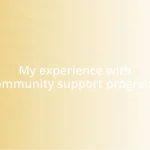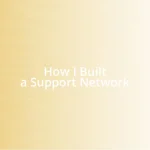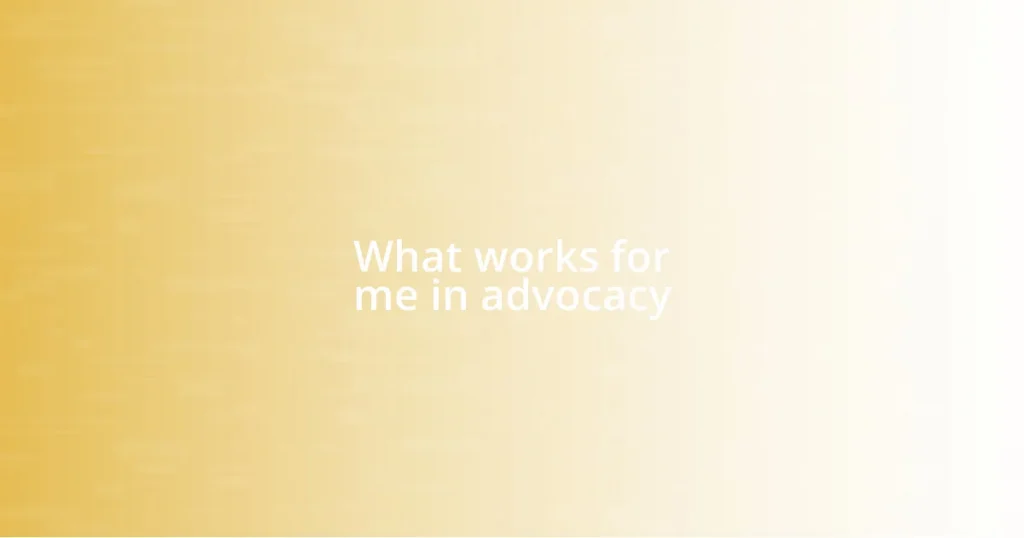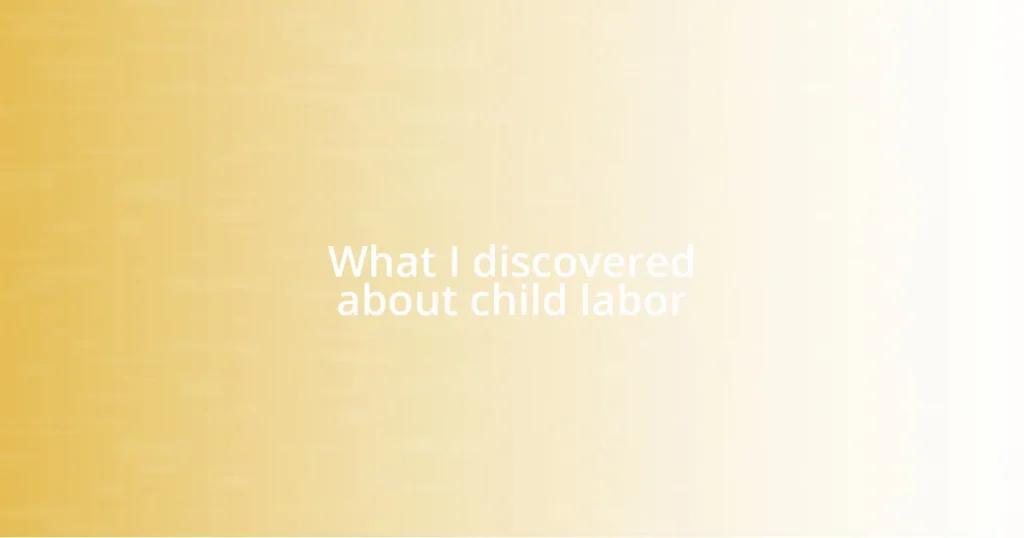Key takeaways:
- LGBTQ+ youth face unique challenges, including discrimination, mental health risks, and a lack of resources, emphasizing the need for supportive communities.
- Creating supportive environments can enhance mental well-being, foster connections, and empower youth to advocate for themselves.
- Education is vital in promoting acceptance and understanding, helping to break down stereotypes and foster empathy among peers.
- Engaging families and advocating for policy changes are crucial for creating a nurturing environment and ensuring the safety of LGBTQ+ youth.

Understanding LGBTQ+ youth issues
Understanding LGBTQ+ youth issues requires us to recognize the unique challenges they face every day. From discrimination at school to the fear of rejection at home, the environment can feel hostile. I remember a friend of mine who struggled to fit in after coming out; their journey was marred by isolation and anxiety, and it made me realize how critical a supportive community is.
Moreover, mental health is a pressing concern. Studies have shown that LGBTQ+ youth are at a higher risk of depression and anxiety compared to their peers. It’s heartbreaking to think about how many bright futures are dimmed by societal pressures and stigma. Have you ever noticed how a single positive encounter can change someone’s outlook? That’s how significant acceptance can be.
Finally, access to resources is crucial. Many LGBTQ+ youth lack information on safe spaces or support groups, leaving them without the tools to navigate their identity. When I first learned about local organizations providing mentorship, it made me wish I had known about them earlier; those connections could be life-changing for someone feeling lost. Understanding these issues is just the first step — we need to foster change that uplifts and protects these young people.

Importance of supportive environments
Creating supportive environments for LGBTQ+ youth is essential for their overall well-being. In my experience, I’ve seen how simply having friends or mentors who affirm a young person’s identity can create a ripple effect of confidence and resilience. When I met a young person in a safe space who could openly talk about their experiences, it was like watching a flower bloom, showcasing how vital encouragement and understanding are.
Supportive environments can drastically reduce feelings of loneliness and isolation. I remember going to a community center event where LGBTQ+ youth shared their stories. The warmth in the room was palpable; I could see young people who had once felt alone begin to connect and form lasting friendships. These moments highlight the power of community; it acts as a lifeline, providing the acceptance that every young person deserves.
Furthermore, these supportive spaces often become platforms for education and advocacy. After attending a pride event, I was blown away by the knowledge shared and the sense of pride that enveloped everyone there. It’s not just about acceptance, but also about empowering youth to embrace their identities and advocate for themselves. In truth, supportive environments cultivate not only individual growth but also a collective strength against adversity.
| Benefits of Supportive Environments | Consequences of Unsupportive Environments |
|---|---|
| Enhanced mental well-being | Increased risk of depression and anxiety |
| Stronger sense of belonging | Feelings of isolation and loneliness |
| Opportunities for personal growth | Stunted personal development |

Role of education in acceptance
Education plays a pivotal role in fostering acceptance for LGBTQ+ youth. I recall a workshop I attended that focused on diversity and inclusion. Hearing personal stories from individuals about their struggles in school opened my eyes; it was unbelievable how some simple conversations led to a profound understanding among students. The power of education lies in its ability to break down stereotypes and build empathy.
- Education nurtures respect and understanding, cultivating a more accepting environment.
- Inclusive curricula can empower students to embrace their peers’ identities, fostering a sense of belonging.
- Educators equipped with training on LGBTQ+ issues can be instrumental in creating a safe space for open dialogue.
- By integrating LGBTQ+ history and achievements into lessons, we can highlight the contributions and struggles of this community, inspiring students to champion acceptance.
In today’s classrooms, I see how essential it is to embrace diversity. Just last month, I witnessed a group of middle schoolers engage in a thoughtful discussion on gender identity during a classroom project. Their innocent yet profound curiosity reminded me how education can challenge biases and promote acceptance. It’s incredible how information, when presented in a supportive manner, can lead to the realization that we are all part of a shared humanity.

Strategies for fostering inclusivity
Fostering inclusivity starts with creating safe spaces where LGBTQ+ youth feel empowered to express their true selves. I remember volunteering at a youth retreat where we encouraged participants to share their talents—whether it was art, music, or storytelling. Watching a shy young artist reveal their work to a supportive audience was a beautiful reminder of how acceptance can ignite passion and build confidence.
In addition to safe spaces, engaging in active allyship is crucial. I once joined a volunteer group dedicated to mentoring LGBTQ+ youth, and let me tell you: offering just a listening ear or a few words of encouragement can transform a young person’s day. Why do we often underestimate the impact of our presence? A simple gesture like standing up against bullying can create a ripple effect that fosters a culture of respect and understanding.
We should also prioritize inclusive extracurricular activities that celebrate diversity. For instance, I attended a local play where the cast represented a diverse range of identities, and it was astonishing to see how the audience connected with the narratives. Isn’t it powerful how stories can bridge gaps between different experiences? Integrating diverse programming not only enriches the community but also reflects the reality that every young person deserves to be seen and valued.

Engaging families in support
Engaging families in supporting LGBTQ+ youth is absolutely essential. I remember when a close friend’s child came out; it was heartwarming to see how she delved into understanding her child’s experience, attending workshops and reading books on acceptance. Isn’t it inspiring how such dedication can create a nurturing environment? Families that actively seek knowledge can make a significant difference in a young person’s life.
It’s important to foster open conversations within families about identity and acceptance. One time, during a family gathering, I suggested we watch a documentary about LGBTQ+ history. The discussions that followed were enlightening, revealing different perspectives and deepening our connections. Engaging in these dialogues not only educates but also strengthens family bonds, laying the groundwork for unconditional support.
Additionally, involving parents in community initiatives can amplify their role as allies. I recall a local Pride event where parents formed a support group, sharing challenges and celebrating their children’s identities. Seeing their camaraderie was a powerful reminder of how connected families could be in creating supportive networks. How often do we overlook the strength found in community? Together, families can forge a united front, truly championing acceptance for LGBTQ+ youth in every aspect of their lives.

Community resources for LGBTQ+ youth
Access to community resources can significantly uplift LGBTQ+ youth, providing them with a sense of belonging and support. I remember attending a local LGBTQ+ youth center where the atmosphere was charged with enthusiasm and acceptance. It felt like a haven where young people could discuss their experiences, share resources, and even participate in workshops that helped them develop real-life skills. Have you ever seen how a safe space can empower someone to embrace their identity fully?
Support hotlines are another vital resource that I’ve found to be incredibly impactful. I once participated in a phone bank for a crisis hotline dedicated to LGBTQ+ individuals, where volunteers provided a listening ear and guidance. Just knowing there’s someone on the other end of the line, ready to listen without judgment, can alleviate so much pressure and loneliness. How many of us appreciate the comfort of having someone who understands your struggles?
Furthermore, mentorship programs tailored for LGBTQ+ youth can make a world of difference. I had the privilege of mentoring a young person through a local program, and the growth I witnessed was astonishing. Watching them gain confidence and navigate their journey with a supportive mentor by their side opened my eyes to the importance of representation. Have you ever thought about how mentorship can help bridge generational gaps and foster a sense of empowerment? It’s truly transformative.

Advocating for policy changes
Advocating for policy changes is crucial for safeguarding the well-being of LGBTQ+ youth. I recall attending a town hall meeting where passionate voices demanded more inclusive policies in schools. Witnessing that level of engagement filled me with hope; it reminded me how collective action can prompt meaningful change. Isn’t it inspiring to see communities rallying for the rights of their most vulnerable members?
One impactful change I believe we need is the implementation of comprehensive anti-bullying laws that explicitly protect LGBTQ+ youth. I once spoke with a brave teenager who shared their experience of relentless bullying in school. Their story drove home the reality that without robust protections, many young people suffer in silence. Have you ever considered how a well-enforced anti-bullying policy could foster a safer environment for learning and self-expression?
Additionally, advocating for mental health resources targeted at LGBTQ+ youth should be a top priority. During a workshop I attended, mental health professionals discussed the unique challenges faced by these young individuals. The stories shared about inadequate access to care were eye-opening, emphasizing the need for systemic change. How often do we think about how mental health resources could not only save lives but also empower LGBTQ+ youth to thrive? It’s time we put these discussions into action at a policy level.















